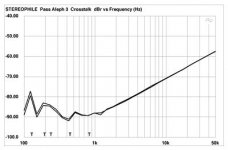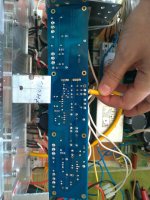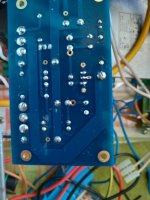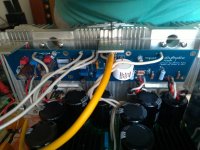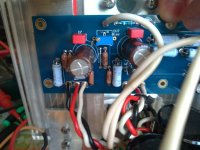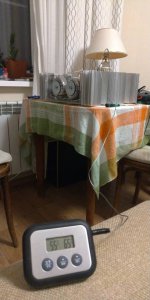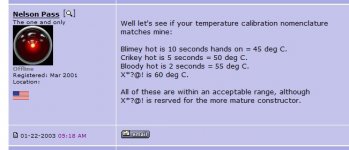kstagger, your question has within it indications you already know the answer: you have indeed angered the amplifier gods!
Build another amp right away. Make it clean and to spec. I suggest a second Aleph.
Hopefully this will appease the gods of amplification and their neighbors the gods of chaos. You must always have at least two amps, that you might service one, then the other without loosing the grace that comes with music.
Build another amp right away. Make it clean and to spec. I suggest a second Aleph.
Hopefully this will appease the gods of amplification and their neighbors the gods of chaos. You must always have at least two amps, that you might service one, then the other without loosing the grace that comes with music.
This morning I turned on system this morning - and, after the first side of a record ended, noticed some strange popping noises coming from the left side; much like an input vacuum tube going bad. Intermittent and high in volume enough to be heard from the sofa.
Troubleshooting - swapping inputs, , etc - narrowed it down to the DIY Aleph. I removed the RCA connector and the popping still continued. I broke out the DMM and checked bias and DC offset. Everything looks good. Swapped speaker cables, and, no surprise, the sound followed the bad channel. With the amp still on, I carefully pushed on capacitors, pulled on wires, even poked at the input JFETs - all to no avail.
Now for the mystery: after swapping everything back to its proper place (with the amp still on!), the popping sound disappeared. An hour later and it isn't back. Needless to say I'm worried it will come back to annoy me.
I believe the Amplifier Gods are mad at me for recently selling the rest of my vacuum tubes and my backup Adcom 😉
It is possible, however probably unlikely, that the RCA sockets developed a bit of oxide deposit (oxidation).... maybe... which you "cleaned" by unplugging and then re-plugging the RCA interconnect cables.
Now, the probability of the above happening, would increase if the amp was in storage for a while...
Hopefully, this will put your mind at ease and you'll forget about the whole thing and enjoy the music🙂
Last edited:
along those lines, maybe take a look at the back of the RCA's to check everything is soldered right and you have a good connection filled cup? Also it could be worthwhile to check continuity from the rca plug to the aleph boards while jiggling/tugging on the wire. I know I've gotten unlucky before with having a fatigued power cord or two where the wires inside start to make a flaky connection.
Separate question;
I'm wanting to try to run a balanced input to the aleph. I know the typical pin1/ground/shield, pin2/+IN, pin3/-IN XLR wiring, but then read all this "Pin 1 problem", floating one side of the shield/grounding only 1 side of the shield to chassis, and then I see all the RCA's wired up to XLR's with a simple Pin 1 to Pin 3 Jumper. I'm super confused.
My intent was to replace the RCA female bulkhead on the back panel with an XLR Female, wired up as noted above, with the shield going into the aleph ground, the IN+ to the IN+, and IN- to IN-. Then rather than have to drill another hole in the backpanel for the RCA, I was going to find or make a Male XLR to Female RCA adapter that connects XLR Pin 1 and Pin 3 to the RCA outer and XLR Pin 2 to RCA Tip. Seems like this matches what Ive seen done direct from Mr. Pass (at least externally with jumpers) as well as some other folks who have put both connectors on the back plate. This seems to not be entirely inline with the pin 1 debate article or floating the shield on one end.
If all goes well, I'll be using the aleph with balanced inputs 99% of the time, but would like to retain the ability to hook up a single ended source on occasion or to be able to try new things without having to replace the connectors/connections inside the chassis.
Separate question;
I'm wanting to try to run a balanced input to the aleph. I know the typical pin1/ground/shield, pin2/+IN, pin3/-IN XLR wiring, but then read all this "Pin 1 problem", floating one side of the shield/grounding only 1 side of the shield to chassis, and then I see all the RCA's wired up to XLR's with a simple Pin 1 to Pin 3 Jumper. I'm super confused.
My intent was to replace the RCA female bulkhead on the back panel with an XLR Female, wired up as noted above, with the shield going into the aleph ground, the IN+ to the IN+, and IN- to IN-. Then rather than have to drill another hole in the backpanel for the RCA, I was going to find or make a Male XLR to Female RCA adapter that connects XLR Pin 1 and Pin 3 to the RCA outer and XLR Pin 2 to RCA Tip. Seems like this matches what Ive seen done direct from Mr. Pass (at least externally with jumpers) as well as some other folks who have put both connectors on the back plate. This seems to not be entirely inline with the pin 1 debate article or floating the shield on one end.
If all goes well, I'll be using the aleph with balanced inputs 99% of the time, but would like to retain the ability to hook up a single ended source on occasion or to be able to try new things without having to replace the connectors/connections inside the chassis.
always come back too slow after the edit ability is removed.
I knew my answer was buried somewhere in these 5000 posts...lol.
Relevant Posts 1162 through 1173. Link below.
Aleph J illustrated build guide
I knew my answer was buried somewhere in these 5000 posts...lol.
Relevant Posts 1162 through 1173. Link below.
Aleph J illustrated build guide
Is it possible that the RCA jack is grounding itself with the backplate? I have never liked the shoulder washers used as the shoulder is thin and short. Always seemed risky to me. This is more a mechanical thing as I am an electrical neophyte at best.
Don
Don
Last edited:
Absolutely wonderful!! Looks fantastic!
😀 😀 😀
Would you mind explaining why having two power supplies is better than one please?
Yes it looks amazing but I just can't understand how there could be more separation or clarity from such a big double unit when a smaller dual unit such as I used for mine seems to do the job totally adequately?
Very happy to receive education. Thanks.
It has always been known that a mono-block approach is better than a single power supply.
If one channel draws a heavy current from the power supply for a transient then that will be transferred into the other channel.
For complete channel separation it is better to have two completely separate power supplies.
If one channel draws a heavy current from the power supply for a transient then that will be transferred into the other channel.
For complete channel separation it is better to have two completely separate power supplies.
Would you mind explaining why having two power supplies is better than one please?
Yes it looks amazing but I just can't understand how there could be more separation or clarity from such a big double unit when a smaller dual unit such as I used for mine seems to do the job totally adequately?
Very happy to receive education. Thanks.
It may well do the job adequately. The only Aleph crosstalk measurements I can find quickly are for the Aleph 3 as measured by Stereophile: Pass Labs Aleph 3 power amplifier Measurements | Stereophile.com. To my knowledge, both channels share a PSU. Can you hear this? I don't know.
If there is no electrical connection between the two channels, this crosstalk is effectively impossible within the power amplifier itself (it may still occur in other devices in the signal chain). Using two power supplies - each with its own transformer - moves the shared direct electrical connection to the AC power connection, far away from the signal and with lots of filtering in between.
Commentary from Nelson Pass is relevant (attached):
Mono Operation
We all know what Mono means, which is a one channel amplifier. Of course, for a channel which does not have to share power resources, it mean an improvement, since in a given size box it can have twice as much transformer and capacitor bank. The other intent is to physically and electrically isolate each power amplifier channel from every other, meeting only at the AC line, and sometimes not even there. This way, whatever is happening on one channel has minimal influence on the others.
Mono operation is very desirable in high end systems, but of course it is expensive. A modest compromise is offered by "dual-mono" operation, in which two channels share the same chassis and power cord, but have separate transformers and supply capacitors. This achieves much of the isolation desired at lesser cost.
Attachments
Last edited:
Thanks so much. I hadn't understood the importance of this configuration.
I can see a few more power supplies in my future.
I can see a few more power supplies in my future.
I hadn't understood the importance of this configuration.
Just to be clear - I have no idea how important the improvement is. Various members have personal opinions and experience with the differences that they have heard, for one reason or another.
All I know is that it can offer an improvement.
Last edited:
Hello, guys. Today's morning i tried to fire up my aleph j boards. One channel started perfectly. I can't control output bias in other channel. Rail voltage is 22-0-22. R27 is set to 68k. I measure 0.56V drop on the R18 resistor. Turning of the r27 makes nothing. Voltage drop across the R18 is constant.
Please help me.
Please help me.
Last edited:
Thank you all. i solved my problem. the problem was fear) i was afraid to rotate R27 to much. Now i set output bias on both channels.
Another approach is to install a fixed 10k resistor in the R27 'jumper' location in addition to the 100k trimmer at the potentiometer location. This makes it easier to make the bias adjustment without having to spend lots of time turning the adjustment screw.
Thank you all. i solved my problem. the problem was fear) i was afraid to rotate R27 to much. Now i set output bias on both channels.
Congratulations! The J is a great amp, Enjoy!
Track temperature is a critical parameter in Formula 1 tyre performance. Because the asphalt of grand prix circuit soaks up heat from the sun it can be considerably warmer than the ambient air temperature, often by 10°C or more.
Hotter track surfaces cause more tyre wear, meaning that soft tyres will last considerably less distance, and that harder tyres may be more optimal for the conditions. Track temperature may rise above 60°C at hot-weather races.
McLaren Racing – Official Website
Hotter track surfaces cause more tyre wear, meaning that soft tyres will last considerably less distance, and that harder tyres may be more optimal for the conditions. Track temperature may rise above 60°C at hot-weather races.
McLaren Racing – Official Website
- Home
- Amplifiers
- Pass Labs
- Aleph J illustrated build guide

